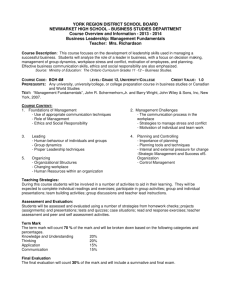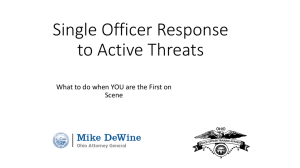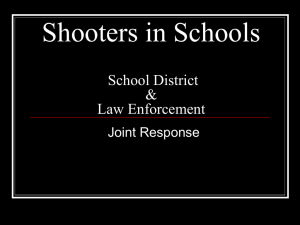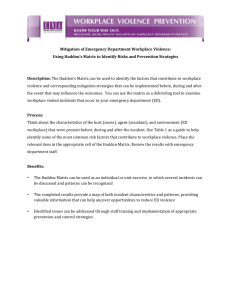Violence in the Workplace September 2015
advertisement
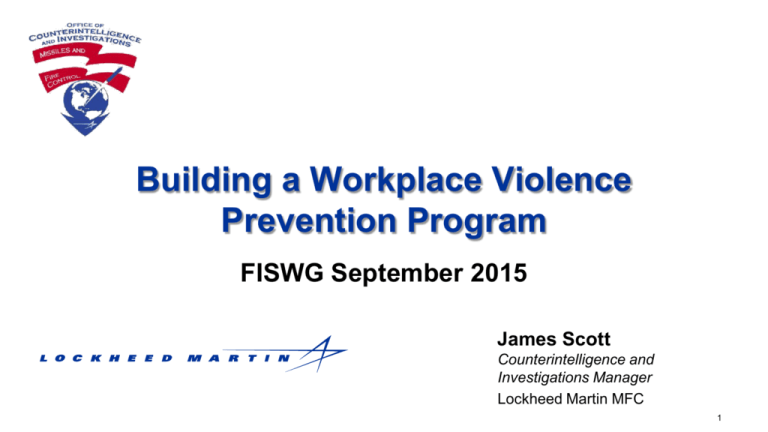
Building a Workplace Violence Prevention Program FISWG September 2015 James Scott Counterintelligence and Investigations Manager Lockheed Martin MFC 1 Agenda • • • • Policy Threat Management Teams Education and Awareness Active Shooter – Plans – Exercises • Insider Threat Tie-in • FSO Case Examples 2 Building a Workplace Violence Prevention Program 3 Policy • Define the Scope – Workplace, as well as, off-premises situations with a relationship to, or that affect the workplace • Define workplace as anywhere work is conducted on companies behalf, ex. TDY, customer location, etc • Company sponsored social events • Domestic violence between two employees • Employees and non-employees • Commonsense “Zero-Tolerance” – Have a Process • Will Investigate any reported violation of policy • Appropriate action will be taken, up to and including termination 4 Policy • Define the Prohibited Conduct – Threatening or actual harm to people or property – May include, but not limited to: • • • • • • • • intentionally attempting to cause or causing actual physical injury possessing or using a weapon in the workplace or while on business intentional, unwelcome physical contact or attempts at such contact threatening (including implied threats and threatening gestures), intimidating, or bullying engaging in aggressive or hostile behavior that creates a reasonable fear of injury in another person intentionally damaging company property or property of another person committing acts of domestic violence stalking, including a pattern of unwanted visits, excessive electronic contact, lying-inwait, following, or conducting surveillance – Define Weapons Policy 5 Policy • Define the Reporting and Response Process – Imminent Threat—Contact 911, or local emergency reporting process – International Reporting Process – Small Site Reporting Process – Identify Who Will Investigate – Employee Removal Process – Reference Crisis Management Process – Threat Management Teams (TMT) 6 Policy • Define Responsibilities: – Employees • Understand Policy and Report Violations • Report an Order of Protection, Restraining Order, or Injunction that would pertain to, or include the workplace – Management • Foster a positive work environment • Ensure employees understand policy and violations will not be tolerated – Define Security Role • Response, Chair TMT, Awareness Training, Investigate, Document – Define HR Role • Consultation, Employment Actions, Investigate, Document 7 Threat Management Teams • Also Known as: • Role: – Reviews the case – Threat Assessment Team (TAT) – Provides consultation to – Case Management Team (CMT) management • Team Consists of: – Recommends appropriate personnel action – Security (Chair) – Directs and reviews investigative – Human resources/Labor Relations process – Legal – Obtains professional consultation, if warranted – Medical • Ad Hoc: – Local FSO Never include direct supervision on TMT • May be friend/ally – Local HR • May Leak Info • May Become Victim – Local Site Mgmt • Too close to situation 8 Threat Management Teams • Best Practices – Teams Must Be Trained! • Threat Assessment Group, INC (TAG) • Center for Personal Protection and Safety (CPPS) – Early Intervention is Key – Think outside the box – “Safety First, Fairness Second” – Teams should be stable • • • • Decreases Training Costs Preserves Evidence Preserves coordination and follow-up 3-5 year commitment desired – Must Follow-up – Have Professional Consultants on retainer 9 Education and Awareness • Develop Standardized Program • Baseline WPVP Awareness Training—Annual re-fresher • Get out in front of Key Employees – New Employee Orientation – New Leader Development • Awareness Campaign – Partner with Communications, Safety and Health Organizations • Invite Key Speakers – Local Law Enforcement – Emergency Management Offices – University Security Directors – Survivors – Harbor House 10 Education and Awareness • Active Shooter Awareness Training – Shots Fired! • 16 min runtime • Center for Personal Protection and Safety (CPPS) – Run. Hide. Fight. • 5 min runtime • Homeland Security, City of Houston 11 Active Shooter Response Understand the Threat • Average active-shooter incident lasts just 12 minutes • Incident often over before police arrive • Active-shooter incidents have tripled sine 2009 • Number of casualties up nearly 150% • 2013 and 2014 yielded in more than 12 active-shooter incidents each, one a month for 2 years! 12 Active Shooter Response • Law Enforcement Coordination Critical • Familiarization Programs – Command Staff Meetings – First Responder Site Visits – Hold Harmless Agreements • Emergency Management Office • Fire Rescue 13 Active Shooter Exercises • Tabletop Exercise (TTX) – Players • Crisis Management Team • Key Stakeholders (HR, Legal, ESH. Facilities) • Local Law Enforcement • Local Fire Rescue • Emergency Management – Detailed Exercise Plan – Team Lead – Evaluators – Observers Focus on improving and understanding the response concept, identify opportunities and challenges and develop solutions 14 Active Shooter Exercises • Full-Scale Exercise (FSX) – Test Company Response Preparedness – Test How Company and First Responders Integrate on Response – Very Large Scale Event! • Logistics, Logistics, Logistics • Safety, Role-players, Volunteers, Food, Props, etc – Exercise Design Team • Homeland Security Exercise and Evaluation Program (HSEEP) Model • Master Scenario of Events List (MSEL) – Hold Harmless Agreements and Consent Forms – Pre-Coordination with First Responders 15 Active Shooter Exercises • Full-Scale Exercise (FSX) – Identify Your Objectives! Example: • On-Scene Incident Management • Emergency Triage and Treatment • Communications • Planning • Information Sharing and Dissemination – Keep Objectives Realistic – Keep Exercises Injects and Scenarios Realistic – Don’t Set Yourself up for Failure! 16 Possible Precipitators • Domestic issues which spill over into workplace (separation, divorce, child custody disputes) • Workplace issues (on-going interpersonal communication or performance-related issues between co-workers, supervisors; corporate downsizing) • Traumatic event (death of significant other, reprimand at work, divorce, arrest) • Substance Abuse (alcohol, prescription drug abuse) • Medical/mental health issues 17 Behaviors of Concern • Strange behavior • Missed deadlines, mistakes, accidents • Depression, frustration • Excessive anger • Absenteeism, tardiness • Violent outbursts • Fixation with weapons • Romantic obsessions • Expressions of unusual or bizarre thoughts • Substance abuse • Changes in habits/personal appearance • Visible stress • Mood swings, arguments, outbursts • Performance problems • Threatening Statements 18 Insider Threat Program How to Tie-in Your Program • Violence, Suicidal Ideations and Insiders share many of the same Behaviors of Concern • Adverse Reporting and Insider Threat Detection Programs may identify potential indicators to potential acts of violence • Combine your Initiatives – Workplace Security Campaign – Prevention of Violence, Suicide and Insider Threats 19 Questions? 20 Contact Info James Scott Intelligence Analysis Manager Counterintelligence/Investigations 407-356-9396 James.o.scott@lmco.com 21

